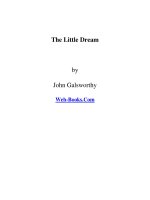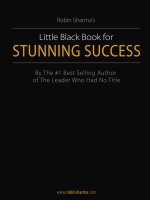Little Eyolf
Bạn đang xem bản rút gọn của tài liệu. Xem và tải ngay bản đầy đủ của tài liệu tại đây (82.39 KB, 11 trang )
Little Eyolf
by
Henrik Ibsen
Web-Books.Com
Little Eyolf
Introduction .......................................................................................................... 3
Characters ............................................................................................................. 8
Act First ................................................................................................................ 9
Act Second........................................................................................................... 38
Act Third............................................................................................................. 62
Introduction
Little Eyolf was written in Christiania during 1894, and published in Copenhagen
on December 11 in that year. By this time Ibsen's correspondence has become
so scanty as to afford us no clue to what may be called the biographical
antecedents of the play. Even of anecdotic history very little attaches to it. For
only one of the characters has a definite model been suggested. Ibsen himself
told his French translator, Count Prozor, that the original of the Rat-Wife was "a
little old woman who came to kill rats at the school where he was educated. She
carried a little dog in a bag, and it was said that children had been drowned
through following her." This means that Ibsen did not himself adapt to his uses
the legend so familiar to us in Browning's Pied Piper of Hamelin, but found it
ready adapted by the popular imagination of his native place, Skien. "This idea,"
Ibsen continued to Count Prozor, "was just what I wanted for bringing about the
disappearance of Little Eyolf, in whom the infatuation [Note: The French word
used by Count Prozor is "infatuation." I can think of no other rendering for it; but I
do not quite know what it means as applied to Allmers and Eyolf.] and the
feebleness of his father reproduced, but concentrated, exaggerated, as one often
sees them in the son of such a father." Dr. Elias tells us that a well-known lady-
artist, who in middle life suggested to him the figure of Lona Hessel, was in later
years the model for the Rat-Wife. There is no inconsistency between these two
accounts of the matter. The idea was doubtless suggested by his recollection of
the rat-catcher of Skien, while traits of manner and physiognomy might be
borrowed from the lady in question.
The verse quoted on pp. 52 and 53 [Transcriber's Note: "There stood the
champagne," etc., in ACT I] is the last line of a very well-known poem by Johan
Sebastian Welhaven, entitled Republikanerne, written in 1839. An unknown
guest in a Paris restaurant has been challenged by a noisy party of young
Frenchmen to join them in drinking a health to Poland. He refuses; they
denounce him as a craven and a slave; he bares his breast and shows the scars
of wounds received in fighting for the country whose lost cause has become a
subject for conventional enthusiasm and windy rhetoric.
"De saae pas hverandre. Han vandred sin vei.
De havde champagne, men rörte den ei."
"They looked at each other. He went on his way. There stood their champagne,
but they did not touch it." The champagne incident leads me to wonder whether
the relation between Rita and Allmers may not have been partly suggested to
Ibsen by the relation between Charlotte Stieglitz and her weakling of a husband.
Their story must have been known to him through George Brandes's Young
Germany, if not more directly. "From time to time," says Dr. Brandes, "there
came over her what she calls her champagne-mood; she grieves that this is no
longer the case with him." [Note: Main Currents of Nineteenth Century Literature,
vol. vi. p. 299] Did the germ of the incident lie in these words?
The first performance of the play in Norway took place at the Christiania Theatre
on January 15, 1895, Fru Wettergren playing Rita And Fru Dybwad, Asta. In
Copenhagen (March 13, 1895) Fru Oda Nielsen and Fru Hennings played Rita
and Asta respectively, while Emil Poulsen played Allmers. The first German Rita
(Deutsches Theater, Berlin, January 12, 1895) was Frau Agnes Sorma, with
Reicher as Allmers. Six weeks later Frl. Sandrock played Rita at the Burgtheater,
Vienna. In May 1895 the play was acted by M. Lugné-Poë's company in Paris.
The first performance in English took place at the Avenue Theatre, London, on
the afternoon of November 23, 1896, with Miss Janet Achurch as Rita, Miss
Elizabeth Robins as Asta, and Mrs. Patrick Campbell as the Rat-Wife. Miss
Achurch's Rita made a profound impression. Mrs. Patrick Campbell afterwards
played the part in a short series of evening performances. In the spring of 1895
the play was acted in Chicago by a company of Scandinavian amateurs,
presumably in Norwegian. Fru Oda Nielsen has recently (I understand) given
some performances of it in New York, and Madame Alla Nazimova has
announced it for production during the coming season (1907-1908).
As the external history of Little Eyolf is so short. I am tempted to depart from my
usual practice, and say a few words as to its matter and meaning.
George Brandes, writing of this play, has rightly observed that "a kind of dualism
has always been perceptible in Ibsen; he pleads the cause of Nature, and he
castigates Nature with mystic morality; only sometimes Nature is allowed the first
voice, sometimes morality. In The Master Builder and in Ghosts the lover of
Nature in Ibsen was predominant; here, as in Brand and The Wild Duck, the
castigator is in the ascendant." So clearly is this the case in Little Eyolf that Ibsen
seems almost to fall into line with Mr. Thomas Hardy. To say nothing of analogies
of detail between Little Eyolf and Jude the Obscure, there is this radical analogy,
that they are both utterances of a profound pessimism, both indictments of
Nature.
But while Mr. Hardy's pessimism is plaintive and passive, Ibsen's is stoical and
almost bracing. It is true that in this play he is no longer the mere "indignation
pessimist" whom Dr. Brandes quite justly recognised in his earlier works. His
analysis has gone deeper into the heart of things, and he has put off the satirist
and the iconoclast. But there is in his thought an incompressible energy of revolt.
A pessimist in contemplation, he remains a meliorist in action. He is not, like Mr.
Hardy, content to let the flag droop half-mast high; his protagonist still runs it up
to the mast-head, and looks forward steadily to the "heavy day of work" before
him. But although the note of the conclusion is resolute, almost serene, the play
remains none the less an indictment of Nature, or at least of that egoism of
passion which is one of her most potent subtleties. In this view, Allmers becomes
a type of what we may roughly call the "free moral agent"; Eyolf, a type of
humanity conceived as passive and suffering, thrust will-less into existence, with
boundless aspirations and cruelly limited powers; Rita, a type of the egoistic
instinct which is "a consuming fire"; and Asta, a type of the beneficent love which
is possible only so long as it is exempt from "the law of change." Allmers, then, is
self-conscious egoism, egoism which can now and then break its chains, look in
its own visage, realise and shrink from itself; while Rita, until she has passed
through the awful crisis which forms .the matter of the play, is unconscious,
reckless, and ruthless egoism, exigent and jealous, "holding to its rights," and
incapable even of rising into the secondary stage of maternal love. The offspring
and the victim of these egoisms is Eyolf, "little wounded warrior," who longs to
scale the heights and dive into the depths, but must remain for ever chained to
the crutch of human infirmity. For years Allmers has been a restless and half-
reluctant slave to Rita's imperious temperament. He has dreamed and theorised
about "responsibility," and has kept Eyolf poring over his books, in the hope that,
despite his misfortune, he may one day minister to parental vanity. Finally he
breaks away from Rita, for the first time "in all these ten years," goes up "into the
infinite solitudes," looks Death in the face, and returns shrinking from passion,
yearning towards selfless love, and filled with a profound and remorseful pity for
the lot of poor maimed humanity. He will "help Eyolf to bring his desires into
harmony with what lies attainable before him." He will "create a conscious
happiness in his mind." And here the drama opens.
Before the Rat-Wife enters, let me pause for a moment to point out that here
again Ibsen adopts that characteristic method which, in writing of The Lady from
the Sea and The Master Builder, I have compared to the method of Hawthorne.
The story he tells is not really, or rather not inevitably, supernatural. Everything is
explicable within this limits of nature; but supernatural agency is also vaguely
suggested, and the reader's imagination is stimulated, without any absolute
violence to his sense of reality. On the plane of everyday life, then, the Rat-Wife
is a crazy and uncanny old woman, fabled by the peasants to be a were-wolf in









